Chennai
| Author:Laxman Burdak, IFS (R) |

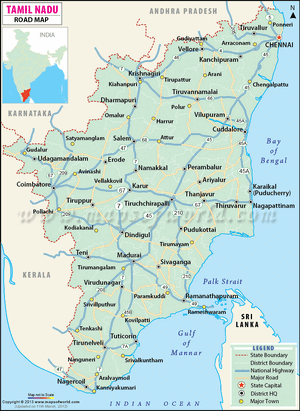
Chennai (चेन्नई) is the capital of the Indian state of Tamil Nadu, Located on the Coromandel Coast off the Bay of Bengal. Chennapattam (चेन्नापटम्) was the ancient name of Chennai, Tamil Nadu. Before 1996 it was known as Madras. In 1996, the Government of Tamil Nadu officially changed the name from Madras to Chennai. Author (Laxman Burdak) visited the place on 15.12.2007 & 16.12.2007 and has provided images and other information.
Origin
Variants
- Chennapattam (चेन्नापटम्) (AS, p.343)
- Chennapatnam (चेन्नापटनम्)
- Chennai (चेन्नई)
- Madras (मद्रास) (AS, p.706)
- Madraspattinam (मद्रासपट्टीनम्)
- Madraspattanam (मद्रासपट्टनम)
- Madarasanpattanam
History
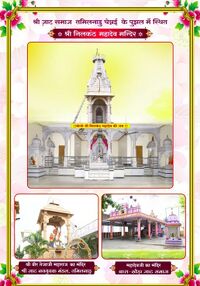
The name Chennai is of Telugu origin.[1] It was derived from the name of a Telugu ruler Damarla Mudirasa Chennappa Nayakudu, father of Damarla Venkatapathy Nayak, a Nayak ruler who served as a general under Venkata III of the Vijayanagar Empire from whom the British acquired the town in 1639.[2] The first official use of the name Chennai is said to be in a sale deed, dated 8 August 1639, to Francis Day of the East India Company, even before[3] the Chennakesava Perumal Temple was built in 1646 [4]
The name Madras is also of native origin, and has been shown to be in use before the British presence in India.[5] A Vijayanagar-era inscription dated to the year 1367 that mentions the port of Madarasanpattanam, along with other small ports on the east coast was discovered in 2015 and it was theorised that the aforementioned port is the fishing port of Royapuram.[6]
According to some sources, Madras was derived from Madraspattinam, a fishing-village north of Fort St George.[7]
On 20 August 1639 Francis Day of the East India Company along with the Nayak of Kalahasti Damarla Chennappa Nayakudu, travelled to the Chandragiri palace for an audience with the Vijayanager Emperor Peda Venkata Raya.[8] Day was seeking to obtain a grant for land on the Coromandel coast on which the Company could build a factory and warehouse for their trading activities and was successful in obtaining the lease of a strip of land about six miles long and one mile inland in return for a yearly sum of five hundred lakh pagodas.[9] The region was then primarily a fishing village known as "Madraspatnam".[10] A year later in 1640, the Company built Fort St. George, the first major English settlement in India,[11] which became the nucleus of the growing colonial city and urban Chennai, grew around this Fort.[12]
In 1996, the Government of Tamil Nadu officially changed the name from Madras to Chennai.
Jat Samaj Tamilnadu

The sociocultural hub of Jats in Tamilnadu is in Puzhal township of northwestern Chennai near Redhill located on national highway 16. Sri Jat Samaj Tamilnadu was established on 20 January 1982, and they also published the Jat Samaj Smarika in 2012. The main office can be reached on phone number 093806 99904, is located 23 km from Adyar at the Main Rd of Kamaraj Nagar in Sakthivel Nagar area of Puzhal township in Chennai. Jat Samaj has built several temples in Puzhal including a grand Neelaknath Mahadev temple (2 km from office), Veer Tejaji Jat Samaj Shiv Mandir (260 m from office) and Sri Tejeshwar Mahadev Temple (400 m from office). Neelaknath Mahadev temple houses the statues of Neelkanth Mahadeva, Sachiyay Mataji, Tejaji, Ganesha, Hanuman and Gangamata. The google map of Jat Samaj office and these temples can be accessed here.
वीर तेजा नवयुवक मंडल तमिलनाडु (चेन्नई) ट्रस्ट द्वारा दिनांक 22.02.2024 को चेन्नई, तमिलनाडु में गंगासागर तट पर बसे कर्मभूमि पुझल में सत्यवादी वीर तेजाजी महाराज एवं आदिदेव प्रतिमाओं के स्थापना का कार्यक्रम आयोजित किया गया है. संपर्क सूत्र Address- 54, Sakthivel Nagar, Main Road, 14th Street, Puzhal Chennai-600066
Mob: 9884936488, 9444790716, 9543888811, 9841650626,6374997201
Major tourist attractions in Chennai
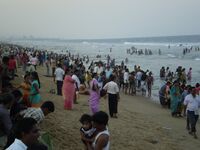
Marina Beach: Marina Beach is a natural urban beach in Chennai, Tamil Nadu, India, along the Bay of Bengal.[13] The beach runs from near Fort Saint George in the north to Foreshore Estate in the south, a distance of 6.0 km making it the longest natural urban beach in the country. The Marina is primarily sandy, unlike the short, rocky formations that make up the Juhu Beach in Mumbai. The average width of the beach is 300 m and the width at the widest stretch is 437 m . Bathing and swimming at the Marina Beach are legally prohibited because of the dangers, as the undercurrent is very turbulent. It is one of the most crowded beaches in the country and attracts about 30,000 visitors a day during weekdays and 50,000 visitors a day during the weekends and on holidays. During summer months, about 15,000 to 20,000 people visit the beach daily.
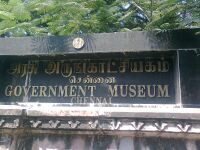
Government Museum, Chennai: The Government Museum or Madras Museum is a museum of human history and culture located in the Government Museum Complex in the neighbourhood of Egmore in Chennai, India. Started in 1851, it is the second oldest museum in India after the Indian Museum in Kolkata and is the tenth oldest Museum in the World. It is particularly rich in archaeological and numismatic collections. It has the largest collection of Roman antiquities outside Europe. Among them, the colossal Museum Theatre is one of the most impressive.[14] The National Art Gallery is also present in the museum premises. Built in Indo-Saracenic style, it houses rare European and Asian painting of renowned artists, including that of Raja Ravi Varma. It is the third largest museum in the world, and with 0.6 million visitors in 2018. It has the richest collections of bronze idols, 500 of them dating to 1000 BC, in Asia.[15]
Location: The museum is located in what is known as the Pantheon complex, or "public assembly rooms." It is located in the Government Museum Complex on Pantheon Road in Egmore. The road on which the museum is located too takes its name from the complex. The Government Museum Complex also houses the Connemara Public Library and the National Art Gallery.
Valluvar Kottam (Tamil: வள்ளுவர் கோட்டம்) (वल्लूवर कोट्टम) is a monument in Chennai, dedicated to the classical Tamil poet philosopher Valluvar. It is the city’s biggest Tamil cultural centre. Location: Valluvar Kottam is located at the intersection of the Kodambakkam High road and the Village road in Nungambakkam neighbourhood of Chennai. The monument now stands at what was once the deepest point of a local lake called the Nungambakkam lake. The construction of the Valluvar Kottam was conceived and executed by the then Chief Minister of Tamil Nadu M. Karunanidhi during the 1970s. It was designed by South Indian traditional architect V. Ganapati Sthapati, who is also the architect of the Thiruvalluvar Statue at Kanyakumari. [16]
The monument: The monument consists of a decorative arch, an auditorium that can accommodate around 3,500 people, and the Kural Manimandapam, where all the 1,330 couplets from all 133 chapters of the Kural literature are inscribed on bas-relief. The hallmark of the monument is the 39-meter-high (128 feet) stone car, a replica of the famed temple chariot of Thiruvarur.[17] The chariot is made of around 3000 blocks of granite stone from Tiruvannamalai and weighs 2,700 tonnes. The largest of these stones weigh as much as 40 tonnes. The four giant-sized wheels of the chariot measure 11 feet in diameter and 2 feet in thickness. A life-size statue of Valluvar has been installed in the chariot. The chariot is adorned with the famed Kalamkari drawings. The bottom portion of the chariot features bas relief sculptures depicting all the 133 chapters of the Kural text. The central auditorium measures 220 feet by 100 feet and is said to be Asia’s largest at the time of its construction. The roof of the monument has a terraced garden with two large pools.[18]
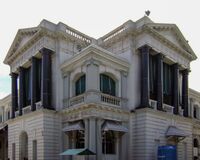
Fort Saint George (फोर्ट सेंट जॉर्ज) is the first English (later British) fortress in India, founded in 1644 at the coastal city of Madras, the modern city of Chennai. The construction of the fort provided the impetus for further settlements and trading activity, in what was originally an uninhabited land. Thus, it is a feasible contention to say that the city evolved around the fortress.The fort currently houses the Tamil Nadu legislative assembly and other official buildings.
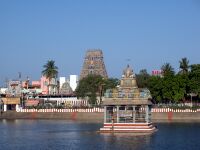
Kapaleeshwarar Temple is a Shiva temple located in Mylapore, Chennai in Tamil Nadu. The form of Shiva's consort Parvati worshipped at this temple is called Karpagambal is from Tamil ("Goddess of the Wish-Yielding Tree"). The temple was built around the 7th century CE and is an example of Dravidian architecture.[19][20] According to the Puranas, Shakti worshipped Shiva in the form of a peacock, giving the vernacular name Mylai (Mayilāi) to the area that developed around the temple - mayil is Tamil for "peacock".[21] Shiva is worshiped as Kapaleeswarar, and is represented by the lingam. His consort Parvati is depicted as Karpagambal. The presiding deity is revered in the 7th century Tamil Saiva canonical work, the Tevaram, written by Tamil saint poets known as the Nayanars and classified as Paadal Petra Sthalam. The temple is maintained and administered by the Hindu Religious and Endowment Board of the Government of Tamil Nadu.
Legend: The temple's name is derived from the words kapāla (head) and Īśvara an alias of lord Shiva. According to the Puranas, during the meeting of Brahma and Shiva at top of Mount Kailash Brahma failed to show the due respect to Shiva. Due to this, Shiva plucked of one of Brahma's heads (kapalams). In an act of penance, Brahma came down to the site of Mylapore and installed a Lingam to please Shiva.[22] This place is known as Sukra Puri, Veda Puri, among many other names including "Kailaye Mayilai and Mayilaye Kayilai "which means this place is equal to kailash. Goddess Karpagambal, a form of Shiva's consort Parvati, due to a curse became a pea-hen and did penance here to get back her original personality. Shiva's son Murugan received the spear (Sakthi Vel) for the destruction of a demon from Parvati here. Brahma had worshipped here to get rid of his ego and get back his power to create. The four Vedas have worshipped here. Sukracharya worshipped the Lord here and got back his lost eye. Rama has worshipped here and won the war against Ravana and brought back Sita from Lanka. The daughter of Sivanesa Chettiar Angam Poompavai got her lost life due to snake bite was later resurrected here by the powers of Thirugnana Sambandar.[23] Vayilar Nayanar, a saiva saint, attained salvation here and Mylapore is also the birth place of Thiruvalluvar who wrote the Thirukkural. In Thevaram special mention is made about the beautiful Madaveedhi as "Malgun Mathri Thavazhum Maada Veedhi Mylappil Ullar". Thiruganana Sambandar, Arunagirinathar have sung the glory of Karpagambal, Singara Velar. The 10-day festival during March / April is a treat to watch and Arubathu Moovar festival is attended by lakhs of devotees every year.[24]
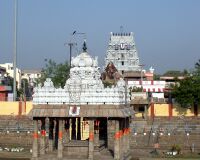
Parthasarathy Temple, Chennai: The Parthasarathy Temple is an 6th-century Hindu Vaishnavite temple dedicated to Vishnu, located at Thiruvallikeni, Chennai, India. The temple is glorified in the Divya Prabandha, the early medieval Tamil literature canon of the Alvar saints from the 6th to 9th centuries CE and is classified as among the 108 Divya Desams dedicated to Vishnu. The name 'Parthasarathy' means the 'charioteer of Arjuna', referring to Krishna's role as a charioteer to Arjuna in the epic Mahabaratha. It was originally built by the Pallavas in the 6th century[25] by king Narasimhavarman I. The temple has icons of five forms of Vishnu: Yoga Narasimha, Rama, Gajendra Varadaraja, Ranganatha and Krishna as Parthasarathy.[26] The temple is one of the oldest structures in Chennai.[27][28]
Legend: As per Hindu legend, Saptarishis, the seven sages worshipped five deities Panchaveeras, namely, Venkata Krishnaswamy, Rukmini, Satyaki, Balarama, Pradyumna and Aniruddha. As per Mahabharatha, Vishnu, in his avatar as Krishna was acting as charioteer for Arjuna, the Pandava prince during the war with Kauravas. Krishna did not take any weapons during the war. During the fight between Arjuna and Bhishma, Krishna was injured by the arrow from Bhishma. The mark in the image in the temple is believed to follow the legend.[10] The place is called Allikeni, meaning a pond of lily as it is believed that historically the place was full of lily ponds. The place is the only place where the presiding deity is sported with a mustache.[11] As per another legend, the place was once a Tulsi forest. A Chola king named Sumati wanted to see Vishnu in the form of Parthasarathi and prayed at Srinivasa temple in Tirupathi. Srinivasa directed the king to visit the temple here built by sage Atreya and worshipped with another sage called Sumati.[29]
History: The temple was originally built by the Pallavas in the 8th century, subsequently expanded by Cholas and later by the Vijayanagara kings in the 15th century.[30] The temple has several inscriptions dating from the 8th century in Tamil and Telugu[31] presumably from the period of Dantivarman, who was a Vishnu devotee. Thirumangai Alvar, the 9th-century alvar also attributes the building of temple to the Pallava king.[32] From the internal references of the temple, it appears that the temple was restored during 1564 CE when new shrines were built. In later years, endowments of villages and gardens have enriched the temple.[33] The temple also has inscriptions about the Pallava king, Nandivarman of the 8th Century.[34]
The temple was extensively built during the Chola period and a lot of inscriptions dating back to the same period are found here. The outer most mandapam is replete with sculptures of various forms of Vishnu, especially the avatars. One can also see inscriptions of Dantivarma Pallava of the 8th century, Chola and Vijayanagara in the temple. The first architectural expansion of the temple took place during the reign of the Pallavas (Tondaiyar Kon) as vividly described by Tirumangai Azhwar. Reminiscent of this is the inscription of the Pallava King Dantivarman (796-847 A.D.), which is preserved in the temple.
The temple witnessed a major expansion during the rule of the Vijayanagar kings like Sadasiva Raya, Sriranga Raya and Venkatapati Raya II (16th century). Many subshrines and pillared pavilions (mandapas) like the Tiruvaimozhi Mandapa were added.
A Pallava king built the present temple in the eighth century. The gopuram was also built by a Pallava king - Tondaiman Chakravarthy. There are inscriptions that record the contributions of the Chola kings Raja Raja and Kulottunga III, Pandya King Maravarman and many rulers of the Vijayanagar dynasty including Ramaraja Venkatapathiraja and Vira Venkatapathy. For a while the East India Company administered the temple.
The pushkarani is called Kairavani and five sacred teerthams are believed to surround the tank - Indra, Soma, Agni, Meena and Vishnu. Seven rishis - Bhrigu, Atri, Marichi, Markandeya, Sumati, Saptaroma and Jabali - performed penance here. All five deities in the temple have been extolled by Tirumangai Azhvar.There is also a separate shrine for Andal, one of the 12 Alvars who is also considered as a consort to the presiding deity.
It is one of the very few shrines in the country dedicated to Krishna as Parthasarathy, charioteer of Arjuna and to contains idols of three avatars of Vishnu: Narasimha, Rama, and Krishna.[35]
Unusually, he is depicted with a prominent moustache and carries a conch in his hand. Also unusual is the iconographical combination found in the sanctum. Here, Krishna is seen standing with consort Rukmini, elder brother Balarama, son Pradyumna, grandson Aniruddha and Satyaki. Because of the association of the temple with Krishna, Tiruvallikeni came to be regarded as the Southern Vrindavana.[36] He also mentioned about the Telliya Singar shrine within the temple.[37]
Chennai Snake Park: Chennai Snake Park is India's first reptile park.[38] Also known as the Guindy Snake Park, it is located next to the Children's Park in the Guindy National Park campus. Located on the former home of the Madras Crocodile Bank Trust, the park is home to a wide range of snakes such as adders, pythons, vipers, cobras and other reptiles. The park gained statutory recognition as a medium zoo from the Central Zoo Authority in 1995.[39]
The park, formerly known as the Madras Snake Park Trust (MSPT), was established by the American-born naturalised Indian herpetologist Romulus Whitaker, who, before coming to India in 1967, had worked with the Miami Serpentarium at Florida, United States. On his arrival to India, he established a small snake park at Selaiyur village, a suburb of Chennai. In 1972, he obtained a piece of land in Guindy on lease from the Forest Department of the Government of Tamil Nadu and, with the help of a group of naturalists from Chennai, set up a bigger park and soon constituted a trust to manage its affairs. The park underwent various renovation after 1994, including an aquarium for sea snakes and turtles and restoration of enclosures and additional facilities. In 1997, the park was renamed as the Chennai Snake Park, following the renaming of the city of Madras in 1996.
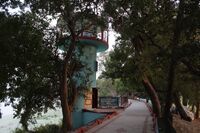
Vedanthangal Bird Sanctuary: Vedanthangal Bird Sanctuary is a 30-hectare protected area located in the Chengalpattu District and Madurantakam taluk of the state of Tamil Nadu, India. The sanctuary is about 75 km from Chennai on [NH45]. Easily reachable from Madurantakam and Chengalpattu. More than 40,000 birds (including 26 rare species), from various parts of the world visit the sanctuary during the migratory season every year.[40] Vedanthangal is home to migratory birds such as pintail, garganey, grey wagtail, blue-winged teal, common sandpiper and the like.[41] Vedanthangal is the oldest water bird sanctuary in the country.[42] Vedanthangal in Tamil language means 'hamlet of the hunter'. This area was a favourite hunting spot of the local landlords in the early 18th century. The region attracted a variety of birds because it was dotted with small lakes that acted as feeding grounds for the birds. Realising its ornithological importance, the British government undertook steps to develop Vedanthangal into a bird sanctuary as early as 1798. This was established in 1858 by the order of the Collector of Chengalpattu.
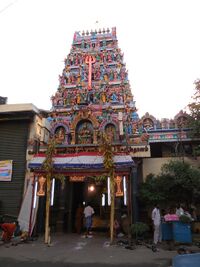
Kalikambal Temple: The Kālikāmbal (कालिकाम्बल मंदिर) Temple is a Hindu temple dedicated to Shri Kāligāmbāl (Kāmākshi) and Lord Kamadeswarar, located in Parry's corner (Old: George Town) locality of the city of Chennai, Tamil Nadu, India. The temple is located in Thambu Chetty Street, a prominent financial street at Georgetown, running parallel to Rajaji Salai.
The temple was originally located closer to the sea shore and was relocated to the current site at 1640 CE. It was then built in 1678.[43] Shivaji, the Maratha warrior and the founder of the Hindawi-Swarajya in the 17th century, had worshiped in this temple incognito on 3 October 1667.[44] It is believed that a fierce form of Goddess was held in worship earlier and that this form was replaced with the shanta swaroopa (calm posture) form of Goddess Kamakshi. Tamil poet Subramaniya Bharathi was a regular visitor of the temple in the early 20th century.[45]
Ramapuram, Chennai - Ramapuram is a neighbourhood in the western part of Chennai, India. It is situated on the Mount-Poonamallee Road at a distance of 3 kilometres from Guindy. Ramapuram forms a part of Maduravoyal taluk, Chennai district. Ramapuram is also famous for Arasamaram Temple which is nearly 100 years old and Lakshmi Narasimha Perumal Temple (Lakshmi Narasimhan idol is approximately 2000 years old). Lakshmi Narashima Perumal temple is one of the oldest temple in Ramapuram. It was around 1200 years old.
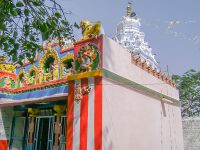
Anjaneya Temple, Nanganallur: The Anjaneya Temple at Nanganallur, Chennai is a Hindu temple dedicated to the god Hanuman. The principal idol of Hanuman is 32-feet tall and sculpted from a single piece of granite, which the second tallest Hanuman after Panchavatee near Puducherry. The idol was installed in 1989 and consecrated in 1995. Sri Maruthi Bhaktha Samajam Trust, consisting of people with high spiritual beliefs, wished for this temple. The Kanchi Paramacharyar entrenched the 32-foot idol of Anjaneyar in 1989 and consummated the Kumbabishekam in 1995. The distinguished factor of the 32-feet idol is that it was molded out of a single rock. [46]
मद्रास
विजयेन्द्र कुमार माथुर[47] ने लेख किया है ...मद्रास (AS, p.706): सन् 1639 ई. में ईस्ट इंडिया कंपनी के कर्मचारी फ़्रांसिस डे ने विजयनगर के राजा से कुछ भूमि लेकर इस नगर की स्थापना की थी। उस समय का बना हुआ क़िला अभी तक विद्यमान है। मद्रास के उपनगर मायलापुर में कपालीश्वर शिव का प्राचीन मंदिर है। मायलापुर का शाब्दिक अर्थ मयूरनगर है। पौराणिक जनश्रुति के अनुसार पार्वती ने मयूर का रूप धारण करके शिव जी की इस स्थान पर पूजा की थी। इसी कथा का अंकन इस मंदिर की मूर्तिकारी में है। मंदिर के पीछे एक पवित्र ताल है। ट्रिप्लीकेन में पार्थसारथी का मंदिर भी उल्लेखनीय है। मद्रास के स्थान पर प्राचीन समय में चेन्नापटम नामक ग्राम बसा हुआ था।
चेन्नापटम्
विजयेन्द्र कुमार माथुर[48] ने लेख किया है ...चेन्नापटम् (AS, p.343) प्राचीन समय में मद्रास (वर्तमान चेन्नई) नगर के स्थान पर बसा हुआ एक ग्राम था। भारतीय इतिहास में यह स्थान इसीलिए महत्त्व का है, क्योंकि अंग्रेज़ ईस्ट इण्डिया कम्पनी ने यहाँ अपना पहला क़िला स्थापित किया था। 1639 ई. में अंग्रेज़ व्यापारी फ़्राँसिस डे ने चेन्नापटम के हिन्दू राजा से इस स्थान का दानपत्र प्राप्त किया था। दानपत्र प्राप्त करने के बाद 1640 ई. में 'फ़ोर्ट सेण्ट जॉर्ज' नामक क़िले की स्थापना की गई, जो अंग्रेज़ों का भारत में पहला क़िला था। 1653 ई. में फ़ोर्ट सेंट जॉर्ज में एक प्रेसीडेंसी स्थापित की गई। आगामी वर्षों में इसी केंद्र के चारों ओर मद्रास नगर का विकास हुआ।
फोर्ट सेंट जॉर्ज, मद्रास
विजयेन्द्र कुमार माथुर[49] ने लेख किया है .....फोर्ट सेंट जॉर्ज, मद्रास (AS, p.599): मद्रास की पुरानी बस्ती का नाम चेन्नापटम् था. इसी ग्राम में 1640 ई. में अंग्रेजी व्यापारी फ्रांसिस डे ने फोर्ट सेंट जॉर्ज की स्थापना की थी. इसी किले के चतुर्दिक भावी महानगरी मद्रास का कालांतर में विकास हुआ. (देखें चेन्नापटम्)
चेन्नई परिचय
चेन्नई का प्राचीन नाम चेन्नापटम् था और 1996 तक मद्रास (AS, p.706) के नाम से जाना जाता था। सन् 1639 ई. में ईस्ट इंडिया कंपनी के कर्मचारी फ़्रांसिस डे ने विजयनगर के राजा से कुछ भूमि लेकर इस नगर की स्थापना की थी। उस समय का बना हुआ क़िला अभी तक विद्यमान है। मद्रास के उपनगर मायलापुर में कपालीश्वर शिव का प्राचीन मंदिर है। मायलापुर का शाब्दिक अर्थ मयूरनगर है। पौराणिक जनश्रुति के अनुसार पार्वती ने मयूर का रूप धारण करके शिव जी की इस स्थान पर पूजा की थी। इसी कथा का अंकन इस मंदिर की मूर्तिकारी में है। मंदिर के पीछे एक पवित्र ताल है। ट्रिप्लीकेन में पार्थसारथी का मंदिर भी उल्लेखनीय है। मद्रास के स्थान पर प्राचीन समय में चेन्नापटम नामक ग्राम बसा हुआ था। चेन्नई धार्मिक संस्थाओं के लिए जाना जाता है। इनमें से रामकृष्ण मंदिर, कालीकंबल मंदिर, सैंथोम चर्च और कपालीश्वर मंदिर प्रमुख है। गर्मी के समय में चेन्नई का मौसम काफी गर्म हो जाता है। हालांकि ठंड का मौसम काफी खुशगवार होता है।
चेन्नापटम् (AS, p.343): प्राचीन समय में मद्रास (वर्तमान चेन्नई) नगर के स्थान पर बसा हुआ एक ग्राम था। भारतीय इतिहास में यह स्थान इसीलिए महत्त्व का है, क्योंकि अंग्रेज़ ईस्ट इण्डिया कम्पनी ने यहाँ अपना पहला क़िला स्थापित किया था। 1639 ई. में अंग्रेज़ व्यापारी फ़्राँसिस डे ने चेन्नापटम के हिन्दू राजा से इस स्थान का दानपत्र प्राप्त किया था। दानपत्र प्राप्त करने के बाद 1640 ई. में फ़ोर्ट सेण्ट जॉर्ज नामक क़िले की स्थापना की गई, जो अंग्रेज़ों का भारत में पहला क़िला था। 1653 ई में फ़ोर्ट सेंट जॉर्ज में एक प्रेसीडेंसी स्थापित की गई। आगामी वर्षों में इसी केंद्र के चारों ओर मद्रास नगर का विकास हुआ।
चेन्नई के दर्शनीय स्थल
फोर्ट सेंट जॉर्ज, मद्रास (Fort Saint George) (AS, p.599): मद्रास की पुरानी बस्ती का नाम चेन्नापटम् था. इसी ग्राम में 1640 ई. में अंग्रेजी व्यापारी फ्रांसिस डे ने फोर्ट सेंट जॉर्ज की स्थापना की थी. इसी किले के चतुर्दिक भावी महानगरी मद्रास का कालांतर में विकास हुआ. सेंट जॉर्ज फोर्ट चेन्नई का एक महत्वपूर्ण आकर्षण है सेंट जॉर्ज फोर्ट। यह किला ईस्ट इंडिया कंपनी का व्यापारिक केंद्र था। 150 वर्षों तक यह युद्धों और षड्यंत्रों का केंद्र बना रहा। इस किले में पुरानी सैनिक छावनी, अधिकारियों के मकान, सेंट मेरी गिरजाघर एवं रॉबर्ट क्लाइव का घर है। यह चर्च अँगरेजों द्वारा भारत में बनवाया गया सबसे पुराना चर्च माना जाता है।
मरीना बीच (Marina Beach): दक्षिण भारत का चेन्नई महानगर में एक प्रसिद्ध बीच है। यह बीच विश्व के सबसे लम्बे तट (बीच) में से एक है। यह भारत का सबसे बड़ा और दुनिया का दूसरा सबसे बड़े समुद्र तटों में गिना जाता है। मरीना बीच भारत के बंगाल की खाड़ी के साथ चेन्नई, तमिलनाडु में एक शहरी क्षेत्र का प्राकृतिक समुद्र तट रहा है। यह तट 13 किमी. रेतीली नदी दक्षिण के बेसंत नगर (Besant Nagar) से उत्तर में फोर्ट सेंट जॉर्ज तक फैला हुआ है। मरीना तट मुख्य रुप से रेतीली-चट्टानी संरचनाओं के विपरित रेतीला है जो मुंबई के जुहू समुद्र तट को दर्शाता है। समुद्र तट की औसत चौड़ाई 300 मी. जबकि पश्चिमी चौड़ाई 437 मी. है। मरीना बीच के खतरों को देखते हुए स्नान तथा तैराकी पर प्रतिबंध लगाया गया है। यह देश के उन सबसे भीड़भाड़ वाले समुद्र तटों में है जहां सप्ताह में 3,000 और छुट्टियों के दिनों लगभग 50,000 के करीब दर्शनार्थी आकर्षण के केन्द्र होते हैं। यहाँ गर्मियों के महिनों और फ़रवरी, नंम्बर महीनों में बिशेष रुप से 15,000 से 20,000 दर्शनार्थियों को आकर्षित करता है। 16 वी. शताब्दी से पहले, समुद्र के स्तर में वृद्धि के फलस्वरूप भूमि जलग्रहण की अनेक घटनाएँ होती थी। लेकिन वहाँ समुद्र पीछे हटने से कई लकीरें और लैगून बन गये। 1880 के दशक में वहाँ के गर्वनर माउंटस्टाट एल्फिंस्टन ग्रांट डफ द्वारा चेन्नई में मरीना बीच का नवीनीकरण किया गया था।
सरकारी संग्रहालय परिसर (Government Museum, Chennai): एगमोर (Egmore) में सरकारी संग्रहालय परिसर में सरकारी संग्रहालय, कोनिमारा सार्वजनिक पुस्तकालय (Connemara Public Library) और राष्ट्रीय कला दीर्घा (National Art Gallery) स्थित हैं। 1851 में स्थापित, छह भवनों और 46 दीर्घाओं वाला संग्रहालय लगभग 16.25 एकड़ क्षेत्र में व्याप्त है। संग्रहालय में प्रदर्शित वस्तुओं में पुरातत्व विज्ञान, मुद्राशास्त्र, प्राणीशास्त्र, प्राकृतिक इतिहास, मूर्तिकला, ताड़ की पत्तियों से निर्मित पांडुलिपियों एवं अमरावती चित्रकला सहित विभिन्न क्षेत्रों से संबंधित शिल्पकृतियां एवं वस्तुएं शामिल हैं। कोनिमारा सार्वजनिक पुस्तकालय भारत के चार राष्ट्रीय संग्रह पुस्तकालयों में से एक है जहां भारत में प्रकाशित होने वाले सभी पुस्तकों, समाचार पत्रों और पत्रिकाओं की एक प्रति उपलब्ध है। 1890 में स्थापित पुस्तकालय सदियों पुराने प्रकाशनों का भंडार है, जिसमें देश की कुछ सर्वाधिक सम्मानित कृतियां एवं संग्रह मौजूद हैं। यह संयुक्त राष्ट्र संघ के लिए एक संग्रह पुस्तकालय के रूप में भी कार्य करता है। राष्ट्रीय कला दीर्घा भवन देश भारतीय-सार्सिनियाई रूप वाले सबसे बेहतरीन स्थापत्यकलाओं में से एक है।
वल्लुवर कोट्टम (Valluvar Kottam): तमिलनाडु की राजधानी चेन्नई में स्थित एक मंदिर है। सन्त कवि वल्लुवर ने तिरुक्कुरल नामक एक पवित्र ग्रंथ लिखा। वल्लुवर कोट्टम मेमोरियल को रथ शैली जैसे मंदिर के आकार में बनवाया गया है जो 39 मीटर ऊँचा और वजन में 2700 टन है। वल्लुवर कोट्टम में एक विशाल ऑडीटोरियम है जिसमें 4000 लोगों की बैठने की व्य्वस्थाध है। वल्लुवर कोट्टम कोडम्बक्कम सड़क और नुंगम्बक्कम सड़क के जंक्शन पर स्थित है.
राष्ट्रीय उद्यान गिंडी (Guindy National Park): 2.76 वर्ग किमी में फैला देश का सबसे छोटा राष्ट्रीय उद्यान गिंडी राष्ट्रीय उद्यान पूर्ण रूप से शहर के भीतर स्थित है। यह हिरण, लोमड़ियों, बंदरों और सांपों की विभिन्न विलुप्तप्रायः किस्मों को सहेजे है। राष्ट्रीय उद्यान में स्थित गिंडी सर्प उद्यान में सांपों का विशाल संग्रह है एवं यह विषरोधी सीरम का एक महत्वपूर्ण स्रोत है।
चेन्नई सर्प उद्यान (Chennai Snake Park): सर्प उद्यान तमिलनाडु के शहर चेन्नई का एक मुख्य पर्यटन स्थल है। इस उद्यान में भारत के लगभग 40 सांपों की प्रजातियाँ हैं। यहाँ मगरमच्छों, गिरगिटों, कछुओं, छिपकलियों और गोह को प्राकृतिक अवस्था में देखा जा सकता है। सर्प उद्यान में सांपों का विशाल संग्रह है एवं यह विषरोधी सीरम का एक महत्त्वपूर्ण स्रोत है।
अन्ना मेमोरियल चेन्नई : अन्ना मेमोरियल, जिसको स्थानीय लोग अन्ना समाधि के नाम से जानते हैं, मरीना समुद्र तट चेन्नई पर निर्मित एक स्मारक है जो तमिलनाडु के पूर्व मुख्यमंत्री C. N. Annadurai की स्मृति में बनाया गया था। यहीं उनका 1969 में अंतिम संस्कार किया गया था। मेमोरियल में अन्नादूरई पर एक म्यूजियम भी है।
वेदांतगल पक्षी विहार (Vedanthangal Bird Sanctuary): यह पक्षी विहार चेंगलपट्टु जिले में स्थित है और चेन्नई से 75 कि.मी. है, देखने गए। यहाँ का ख़ास आकर्षण 'वाच टॉवर ' और वहाँ बनी पक्षियों की तस्वीर हैं जिनकी सहायता से पक्षियों को आसानी से पहचाना जा सकता है। वेदान्थांगल पक्षी अभयारण्य दो कारणों के लिए देश भर के पक्षी प्रेमियों का तथा पक्षीवैज्ञानिकों का ध्यान आकर्षित करती है। सबसे पहले, यह भारत में स्थापित किए गए प्रथम पक्षी अभयारण्यों में से एक है जिसका इतिहास ब्रिटिश शासन काल जितना पुराना है। दूसरा, इस अभयारण्य को जो राष्ट्रव्यापी महत्व मिलता है इसका श्रेय इस अभयारण्य के संरक्षण के लिए दिए गए स्थानीय समुदायों के लोगों की भागीदारी को जाता है। विविध प्रकार के प्रवासी पक्षियों के कारण वेदान्थांगल पक्षी अभयारण्य देश भर से पक्षी प्रेमियों को आकर्षित करता है। इस अभयारण्य में देखे जाने वाले दुर्लभ और विदेशी पक्षियों की प्रजातियों में कलहंस, ऑस्ट्रेलिया का ग्रे हवासील, श्रीलंका का ड़ार्टर, ग्रे बगुला, ग्लॉसी आइबिस, ओपन बिल सारस, साइबेरियाई सारस, स्पॉट बिल हंस शामिल हैं। इस अभयारण्य में अनगिनत छोटी झीलें मौजूद हैं और यह 74 एकड़ के क्षेत्र में फैला है। नवंबर और दिसंबर के महीनों में इस अभयारण्य में यूरोपीय प्रजाति के कई दुर्लभ पक्षी देखे जा सकते हैं। पक्षियों के लिए महत्वपूर्ण वृक्ष प्रजातियाँ हैं- Baringtonia sp. और Acacia nilotica. [50]
अरिग्नार अन्ना प्राणी उद्यान (Arignar Anna Zoological Park): इसे वन्डालुर चिड़ियाघर के नाम से बेहतर रूप में जाना जाता है। चेन्नई शहर के दक्षिण पश्चिम में 31 किमी दूरी पर स्थित है और 5.1 वर्ग किमी क्षेत्र में फैला हुआ है। यहां प्रदर्शन करने के लिए अस्सी प्रजातियां हैं और इसमें एक शेर सफ़ारी, एक हाथी सफ़ारी, एक निशाचर पशु घर और एक मछलीघर शामिल हैं। शहर के दक्षिण में, ईस्ट कोस्ट रोड के किनारे, उभयचर प्राणिविज्ञान संबंधी अनुसंधान का एक महत्वपूर्ण केन्द्र है जिसे मद्रास क्रोकोडाइल बैंक ट्रस्ट कहा जाता है, जिसमें कई ताजे पानी और खारे पानी वाले मगरमच्छों, ग्राहों, घड़ियालों और कछुए तथा सांपों का भी आवास है। उद्यानकृषि (बागवानी) विभाग के वनस्पति उद्यान में पौधों की एक बहुत व्यापक विविधता है और 2 करोड़ वर्ष पुराना एक जीवाश्मीकृत पेड़ का तना भी है। हर वर्ष यहां मई के महीने में एक ग्रीष्मकालीन समारोह आयोजित किया जाता है।
कपालीश्वर मंदिर (Kapaleeshwarar Temple): चेन्नई का एक प्रसिद्ध शिव मंदिर है। यहाँ पार्वती का जो रूप पूजित है, उसे तमिल में 'कर्पागम्बल' कहते हैं, जिसका अर्थ है- 'कृपा वृक्ष'। यह मन्दिर द्रविड शैली में है और इसकी स्थापना 7वीं शताब्दी के आसपास हुई थी। कपालीश्वर मंदिर चेन्नई के उपनगर मायलापुर में स्थित है। यह मंदिर भगवान शिव और पार्वती को समर्पित है। यहां पार्वती की पूजा करपागंबल के रूप में किया जाता है। इस मंदिर का नाम कपलम और ईश्वरर पर पड़ा है। कपलम का अर्थ होता है सर, जबकि इश्वरर भगवान शिव का दूसरा नाम है। हिंदू पौराणिक कथाओं के जब भगवान ब्राह्मा और भगवान शिव माउंट कैलाश की चोटी पर मिले तो ब्राह्मा भगवान शिव की श्रेष्ठता को पहचान नहीं पाये। इससे कुपित होकर शिव ने ब्राह्मा का सर पकड़कर खींच दिया। अपनी गलती को सुधारने के लिए ब्राह्मा मायलापुर आ गए और यहां उन्होंने शिवलिंग की स्थापना की। ऐसी मान्यता है कि इस मंदिर का निर्माण सातवीं शताब्दी के आसपास पल्लव राजाओं ने किया था। इस मंदिर की वास्तुशिल्पय बनावट द्रविड शैली से काफी मिलती जुलती है। कहा तो यह भी जाता है कि मूल मंदिर उस स्थान पर बना था जहां आज सैंथोम चर्च बना हुआ है। वर्तमान समय के मंदिर को विजयनगर के राजाओं ने 16वीं शताब्दी में बनवाया था। [51]
पार्थसारथी मंदिर (Parthasarathy Temple): चेन्नई के त्रिपलीकेन (Tiruvallikeni) में बना पार्थसारथी मंदिर भगवान कृष्ण को समर्पित है। ऐसा माना जाता है कि इस मंदिर को 6वीं शताब्दी में बनवाया गया था। पार्थसारथी एक संस्कृत शब्द है, जिसका अर्थ होता है अर्जुन का सारथी। महाभारत की लड़ाई में भगवान कृष्ण भी अर्जुन की सारथी का हिस्सा थे। त्रिपलीकेन स्थित भगवान कृष्ण का मंदिर पल्लव राजा नरसिम्हावर्मन प्रथम द्वारा मान्यताप्राप्त था। मंदिर के अंदर भगवान विष्णु, कृष्णा, नरसिम्हा, राम और वराह के विभिन्न अवतारों को रखा गया है। भगवान राम और भगवान नरसिम्हा के तीर्थ स्थल के लिए अलग प्रवेश द्वार बना हुआ है। चेन्नई का सबसे पुराना निर्माण होने के कारण भी इस मंदिर की प्रसिद्धी है। इसी कारण से यहां बड़ी संख्या में पर्यटक आते हैं। इसके अलावा मंदिर के स्तंभों और दीवारों पर बेहतरीन नक्काशी भी की गई है। यहाँ क़ृष्ण को रुक्मिणी, बड़े भाई बलराम, पुत्र प्रद्युम्न, पौत्र अनिरुद्ध और सत्यकी के साथ खड़ा दिखाया गया है. क़ृष्ण के साथ संबंध होने के कारण त्रिपलीकेन (Tiruvallikeni) को दक्षिण का वृंदावन भी कहा जाता है. [52]
कालीकंबल मंदिर : चेन्नई कालीकंबल मंदिर जॉर्ज टाउन में थंबू छेट्टी स्ट्रीट में स्थित है। शहर का एक प्रमुख आर्थिक केन्द्र होने के कारण यह एक चर्चित स्थान है। यह मंदिर हिंदू देवी कालीकंबल को समर्पित है, जिसे भारत के कई हिस्सों में देवी कमाक्षी के रूप में भी पूजा जाता है। वर्तमान के कालीकंबल मंदिर को 1640 में उस समय बनवाया गया था जब मूल मंदिर नष्ट हो गया था। पुराना मंदिर समुद्र तट के किनारे था और ऐसा माना जाता है कि पुर्तगाली आक्रमणकारियों ने मंदिर को नष्ट किया था। स्थानीय पौराणिक कथा के अनुसार कभी इस मंदिर में देवी कमाक्षी की एक उग्र रूप की पूजा की जाती थी। देवी के इस रूप को काफी आक्रमक और शक्तिशाली माना जाता था। बाद में देवी के उग्र रूप के स्थान पर कम आक्रमक और ज्यादा शांत देवी कालीकंबल को स्थापित किया गया। देवी कमाक्षी के इस अवतार को शांता स्वरूप माना जाता है। [53] शिवाजी, मराठा योद्धा और 17 वीं शताब्दी में हिंदवी-स्वराज्य के संस्थापक ने 3 अक्टूबर 1667 को इस मंदिर में पूजा की थी।
External links
References
- ↑ S. Muthiah (2008). Madras, Chennai: A 400-year Record of the First City of Modern India. Palaniappa Brothers. ISBN 978-81-8379-468-8.
- ↑ "District Profile, Chennai". Government of Tamil Nadu.
- ↑ "District Profile – Chennai". District Administration, Chennai.
- ↑ Muthiah, S. (4 March 2012). "The 'Town Temple' resurrected". The Hindu. Chennai, India
- ↑ Krishnamachari, Suganthy (21 August 2014). "Madras is not alien" – via www.thehindu.com.
- ↑ Krishnamachari, Suganthy (21 August 2014). "Madras is not alien". The Hindu (Friday Review).
- ↑ Rangaraj, R (22 July 2019). "When 'Madras' was inscribed in history 652 years ago" – via www.timesofindia.com.
- ↑ Velcheru Narayana Rao, David Shulman, Sanjay Subrahmanyam (1998). Symbols of substance : court and state in Nayaka period Tamilnadu. Oxford : Oxford University Press, Delhi. p. xix, 349 p., [16] p. of plates : ill., maps ; 22 cm. ISBN 0-19-564399-2.
- ↑ Heras, H. (1 July 1927). "South India Under The Vijayanagar Empire Vol. 1" – via Internet Archive.
- ↑ R., Vaidyanadhan (31 August 2009). "Chennai Coins-the Vijayanagara Connection". The Hindu.
- ↑ Roberts J. M. (1997). A short history of the world. Helicon publishing Ltd. p. 277. ISBN 978-0-19-511504-8.
- ↑ Wagret, Paul (1977). Nagel's encyclopedia-guide. "India, Nepal". Geneva: Nagel Publishers. p. 556.
- ↑ http://tamilnadu.com/travel/marina-beach.html
- ↑ Suresh, S. (21 May 2011). "Times Property Section". The Times of India. Chennai: The Times Group. p. 2.
- ↑ "Demand for audio-guides at museum for information on artefacts"
- ↑ Muthiah, S. (2014). Madras Rediscovered. Chennai: EastWest. p. 461. ISBN 978-93-84030-28-5.
- ↑ Kabirdoss, Yogesh (18 July 2018). "Neglect leading Valluvar Kottam to ruin". The Times of India. Chennai: The Times Group.
- ↑ Muthiah, S. (2014). Madras Rediscovered. Chennai: EastWest. p. 461. ISBN 978-93-84030-28-5.
- ↑ Silas, Sandeep (2007). Discover India by Rail. New Delhi: Sterling Publishers. ISBN 978-81-207-2939-1.p. p. 114
- ↑ Kamath, Rina (2000). Chennai. Chennai: Orient Longman Limited. ISBN 81-7835-014-9. pp.28-31
- ↑ Hurd, James (2010). Temples of Tamilnad. USA: Xilbris Corporation. ISBN 978-1-4134-3843-7. p.36
- ↑ V., Meena (1974). Temples in South India (1st ed.). Kanniyakumari: Harikumar Arts. p. 46.
- ↑ Kamath 2002, pp.28-31
- ↑ Kamath 2002, pp.28-31
- ↑ Sullivan 1997, p. 126
- ↑ Let's Go India & Nepal 8th Ed By Jane Yang, Let's Go, Inc., Inc. Let's Go
- ↑ Kamath 2000, p. 275
- ↑ There are shrines for Vedavalli Thayar, Ranganatha, Rama, Gajendra Varadar, Narasimha, Andal, Hanuman, Alvars, Ramanuja, Swami Manavala Mamunigal and Vedanthachariar. The temple subscribes to Vaikhanasa agama and follows Thenkalai tradition. There are separate entrances and Dwajastambhas for the Parthasarathy and Yoga Narasimha temples. The gopuram (towers) and mandapas (pillars) are decorated with elaborate carvings, a standard feature of South Indian Temple Architecture. "Official Website". Parthasarathy Temple, Official Website.
- ↑ R., Dr. Vijayalakshmy (2001). An introduction to religion and Philosophy - Tévarám and Tivviyappirapantam (1st ed.). Chennai: International Institute of Tamil Studies. pp. 440–2.
- ↑ Kamath 2002, pp. 31–33
- ↑ Kamath 2002, pp. 31–33
- ↑ Madras Tercentenary Celebration Committee, pp. 356–357
- ↑ Ayyar, P. V. Jagadisa (1991). South Indian shrines: illustrated. New Delhi: Asian Educational Services. ISBN 81-206-0151-3. pp. 19–20
- ↑ Lalithasai (18 December 2011). "Religious facets of Thirumayilai, Thiruvallikeni". The Hindu.
- ↑ Let's Go India & Nepal 8th Ed By Jane Yang, Let's Go, Inc., Inc. Let's Go
- ↑ T.Padmaja (2002). Temples of Krsna in South India. Dravidaveda.org. Abhinav Publications, New Delhi. ISBN 81-7017-398-1.
- ↑ Madras Tercentenary Celebration Committee, pp. 356–357
- ↑ "Agumbe Rainforest Research Station". ARRS.
- ↑ "List of Zoos, whose Master Plan received till 31st March, 2011" (PDF). Central Zoo Authority of India. 2011.
- ↑ D, Madhavan (18 November 2013). "Bird sanctuaries to open on Friday". The Hindu. Chennai.
- ↑ Vedanthangal - M.Krishnan pg.9
- ↑ D, Madhavan (18 November 2013). "Bird sanctuaries to open on Friday". The Hindu. Chennai.
- ↑ "1639 A.D. TO 1700 A.D." History of Chennai. ChennaiBest.com.
- ↑ "Chennai High: Where history beckons". The Times of India. Chennai: The Times Group. 27 August 2010.
- ↑ Muthiah, S. (2014). Madras Rediscovered. Chennai: EastWest. p. 384. ISBN 978-93-84030-28-5.
- ↑ http://www.nanganalluranjaneyartemple.tnhrce.in/
- ↑ Aitihasik Sthanavali by Vijayendra Kumar Mathur, p.706
- ↑ Aitihasik Sthanavali by Vijayendra Kumar Mathur, p.343
- ↑ Aitihasik Sthanavali by Vijayendra Kumar Mathur, p.599
- ↑ https://hindi.nativeplanet.com/vedanthangal/attractions/vedanthangal-bird-sanctuary/#overview
- ↑ https://hindi.nativeplanet.com/chennai/attractions/kapaleeshwar-temple/#overview
- ↑ https://hindi.nativeplanet.com/chennai/attractions/parthasarathy-temple/
- ↑ https://hindi.nativeplanet.com/chennai/attractions/kalikambal-temple/#overview


















